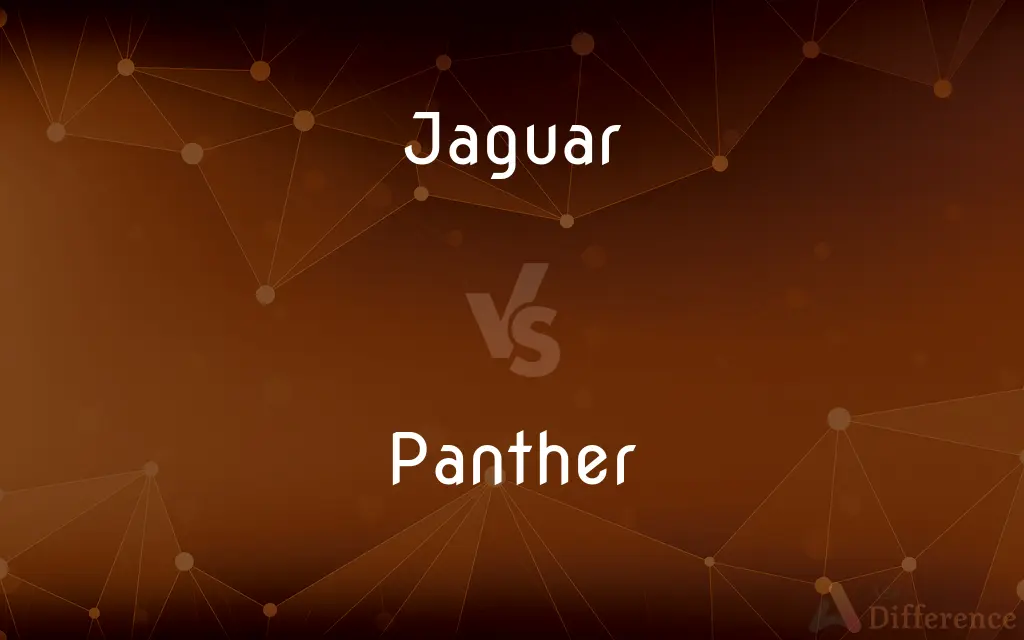Jaguar vs. Panther — What's the Difference?
Edited by Tayyaba Rehman — By Fiza Rafique — Updated on September 24, 2023
A jaguar is a large wild cat native to the Americas. A panther is a generic term that refers to a big cat, especially melanistic ones. While "jaguar" is species-specific, "panther" can be used for various big cats.

Difference Between Jaguar and Panther
Table of Contents
ADVERTISEMENT
Key Differences
A jaguar is one of the big cats primarily found in the rainforests of Central and South America. Known for its strength and agility, this spotted feline is third in size, following the tiger and lion. On the contrary, the term panther isn't restricted to a single species but is a generic name that encompasses a range of big cats, based on the region and context.
In terms of physical attributes, the jaguar has a robust build with a distinct coat pattern characterized by rosettes with spots inside them. However, when people mention a black panther, they might be referring to a melanistic jaguar (or leopard) that has an excess of black pigments, making its fur appear dark, but often with the ghostly outline of its rosettes visible.
Regionally, the term panther changes in its reference. In the Americas, a panther might be understood as a jaguar or a cougar. In Africa or Asia, it could mean a leopard, especially the black variant. Jaguars don't have this flexibility in meaning; they are a distinct species with a unique identity.
An interesting overlap occurs with melanism. Melanistic jaguars and leopards are both called black panthers. Thus, while jaguar defines a specific big cat, the word panther is more about context and can refer to different cats based on their location and coloration.
Comparison Chart
Definition
A big cat species native to the Americas.
A general term for big cats, often melanistic ones.
ADVERTISEMENT
Physical Appearance
Rosettes with spots, robust build.
Can vary, but often refers to melanistic big cats.
Geographic Distribution
Primarily Central and South America.
Refers to big cats globally, based on region.
Melanism
Can be melanistic and called a black panther.
Term often used for melanistic jaguars or leopards.
Species-Specific
Yes, refers specifically to Panthera onca.
No, can refer to jaguars, leopards, or other big cats.
Compare with Definitions
Jaguar
A large spotted feline native to the Americas.
The jaguar is known for its powerful build and distinct coat patterns.
Panther
A general term for various big cats, especially melanistic ones.
The black panther seen in Asia is usually a melanistic leopard.
Jaguar
An animal known for its strength, agility, and swimming ability.
Unlike many big cats, jaguars often hunt in water and are adept swimmers.
Panther
Not species-specific, dependent on region and context.
Depending on where you are, a panther might refer to different big cats.
Jaguar
The third-largest big cat species, after the tiger and lion.
Jaguars are apex predators in their habitats, asserting dominance in the animal hierarchy.
Panther
In the Americas, might refer to jaguars or cougars.
The panther spotted in Florida was likely a cougar.
Jaguar
A carnivorous mammal primarily found in Central and South American rainforests.
The jaguar's diet consists mainly of deer, peccaries, and capybaras.
Panther
In Africa or Asia, generally references a leopard.
When on safari in Africa, they sighted a panther resting in a tree.
Jaguar
Recognized by its rosette-patterned coat with spots inside.
The jaguar's coat provides camouflage, allowing it to stealthily approach prey.
Panther
A large wild cat such as a leopard or jaguar, especially in a color form with black fur.
Jaguar
The jaguar (Panthera onca) is a large felid species and the only living member of the genus Panthera native to the Americas. Its distinctively marked coat features pale yellow to tan colored fur covered by spots that transition to rosettes on the sides.
Panther
See cougar.
Jaguar
A large feline mammal (Panthera onca) of Mexico, Central America, and South America, closely related to the leopard and having a tawny coat spotted with black rosettes.
Panther
Any of various big cats with black fur; most especially, the black-coated leopard of India.
Jaguar
A carnivorous spotted large cat native to South and Central America, Panthera onca.
Panther
Any big cat of the genus Panthera.
Jaguar
A large and powerful feline animal (Panthera onca, formerly Felis onca), ranging from Texas and Mexico to Patagonia. It is usually brownish yellow, with large, dark, somewhat angular rings, each generally inclosing one or two dark spots. It is chiefly arboreal in its habits. It is also called the panther and the American tiger.
Panther
A cougar; especially the Florida panther.
Jaguar
A large spotted feline of tropical America similar to the leopard; in some classifications considered a member of the genus Felis
Panther
(slang) A girl, especially a young one, who pursues older men.
Paige is 16 and dates a 19 years old guy, she's such a panther.
Panther
A creature resembling a big cat with a multicolored hide, found in Ancient Greek mythology.
Panther
A large dark-colored variety of the leopard, by some Zoologists considered a distinct species. It is marked with large ringlike spots, the centers of which are darker than the color of the body.
Panther
In America, the name is applied to the puma, or cougar, and sometimes to the jaguar.
Panther
A large spotted feline of tropical America similar to the leopard; in some classifications considered a member of the genus Felis
Panther
A leopard in the black color phase
Panther
Large American feline resembling a lion
Panther
Often used to describe dark-colored or black big cats.
The black panther's coat can sometimes reveal ghostly rosettes beneath.
Common Curiosities
How does a panther differ from a jaguar?
"Panther" is a broad term for big cats, often melanistic ones, while "jaguar" specifically refers to a species in the Americas.
Can a jaguar be called a panther?
Yes, when referring to a melanistic jaguar, it's often termed a "black panther."
What is a jaguar?
A jaguar is a large wild cat native to the Americas, recognized by its spotted coat.
Are all panthers black?
No, "panther" is a broad term, but "black panther" specifically refers to melanistic big cats.
Is a jaguar larger than a panther?
This is tricky because "panther" is a generic term. However, jaguars are generally larger than leopards, which are sometimes called panthers.
Is a panther a distinct species like a jaguar?
No, "panther" is a generic term and can refer to different big cats, including jaguars and leopards.
Where are jaguars predominantly found?
Jaguars are mainly found in the rainforests of Central and South America.
In Florida, when someone says "panther," what do they likely mean?
In Florida, "panther" usually refers to the Florida panther, a subspecies of cougar.
What's distinctive about a jaguar's coat pattern?
Jaguars have rosettes with spots inside them on their coats.
What's the primary diet of a jaguar?
Jaguars are carnivores, feeding on deer, peccaries, capybaras, and other animals.
What does "black panther" usually refer to?
It often refers to melanistic big cats, either jaguars in the Americas or leopards in Africa and Asia.
Can a panther be a leopard?
Yes, especially in Africa and Asia, the term "panther" can refer to leopards, including melanistic ones.
Share Your Discovery

Previous Comparison
Milkshake vs. Malt
Next Comparison
Transpiration vs. GuttationAuthor Spotlight
Written by
Fiza RafiqueFiza Rafique is a skilled content writer at AskDifference.com, where she meticulously refines and enhances written pieces. Drawing from her vast editorial expertise, Fiza ensures clarity, accuracy, and precision in every article. Passionate about language, she continually seeks to elevate the quality of content for readers worldwide.
Edited by
Tayyaba RehmanTayyaba Rehman is a distinguished writer, currently serving as a primary contributor to askdifference.com. As a researcher in semantics and etymology, Tayyaba's passion for the complexity of languages and their distinctions has found a perfect home on the platform. Tayyaba delves into the intricacies of language, distinguishing between commonly confused words and phrases, thereby providing clarity for readers worldwide.












































